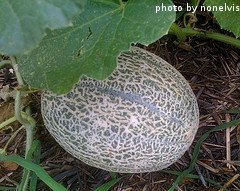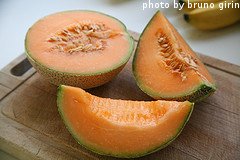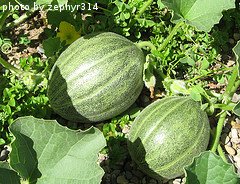Growing Cantaloupe
You should strongly consider growing cantaloupe if you have enough space in your garden and you love fresh fruit. Fresh melons from you garden usually taste much better than those found in the grocery store. Cantaloupe are simple to plant, easy to care for and even simpler to harvest. Fresh picked melons also last for several days in the refrigerator.
Cantaloupe plants are vines that can get rather long, so they are generally reserved for traditional vegetable gardens and are not suitable for growing in containers. In recent years, some bush varieties of cantaloupe have been developed for those with limited space. However, these bush varieties still get too large to be grown in average-sized containers for the most part.

If you want to grow cantaloupe but only have limited space, you can try growing them vertically. The vines are fairly strong and if given a sturdy support structure, the plants will produce just as much fruit growing up as they will growing out. If you decide to grow cantaloupe vertically, choose a variety that produces somewhat smaller fruit. Heavy melons hanging from a vine could easily cause damage to the plant. It is possible to support the growing melons with a sling made from flexible material like panty hose. The key is to make sure you attach the sling extremely well to the support structure and under the fruit so that as the melon grows, it will be cradled by the sling.
Cantaloupe need at least 6-8 hours of sunlight per day to thrive - the more the better. They also need lots of room to spread out and should be planted at least 6 feet away from other plants in your garden. Cantaloupe are summer fruit and do well in hot, humid environments. They should be planted after the soil has warmed up in the spring. The seeds typically germinate best when soil temperatures are in the 75-85 degree F range. The melons are usually ready for harvest in mid to late summer.
Cantaloupe do best when the seeds are sown directly in the garden rather than transplanting seedlings. However, if you have a short growing season, it is possible to start the seeds in biodegradable pots and then transplant them when it gets warm enough. They require loose soil that drains well and is rich in nutrients. Most cantaloupe plants will produce 4-8 fruit each. The fruit is ready for harvest 70-100 days after germination, depending on the variety.
Most varieties of cantaloupe produce fruit weighing 2-6 pounds. Think about how big you want the melons to be when choosing which variety of cantaloupe to grow. If you like to eat a half a cantaloupe with cottage cheese in the middle a couple of times a week, you might choose a smaller variety. If you want large slices and you have plans to freeze it or use it in a bunch of different recipes, you might choose a bigger variety. Also think about how much space you have as some varieties tend to spread out more than others. The world record cantaloupe was grown in Alaska and weighed almost 65 pounds.

Cantaloupe are packed with vitamins and are very nutritious. They can be used in a wide variety of recipes including juices, salads and can even be boiled, sauteed, smoked, grilled and even made into soup.
Quick Overview of Growing Cantaloupe
Planting: Sow seeds 1/2 inch deep in mounds that are 3-4 feet across, space mounds 6 feet apart, sow 6 seeds per mound and thin to 3-4 seeds per mound
Fertilizing: Use well-balanced fertilizer and apply once when plants reach 4 inches tall and again when blossoms appear
Watering: Plants need about 1 inch of rain per week, keep soil moist but not wet
Harvesting: Pick melons when they easily slip from vines and most of green netting has disappeared
Recipes: Cantaloupe can be eaten raw or cooked, and preserved by freezing
In our own garden we usually grow a couple of a different varieties of cantaloupe. We try to choose varieties that mature at different times so that we get to enjoy the fresh melons for several weeks. We also try to grow enough to have a few to give away to friends and neighbors. One of our favorite snacks in the summer is prosciutto wrapped melon - we love the combination of the sweetness and juiciness of the cantaloupe with the saltiness and dryness of the prosciutto. Another tradition in our house during the hot summer months is using fresh cantaloupe to make sorbet.
Click on the following links to learn more about growing cantaloupe.

Click here for information about planting cantaloupe
Click here to learn about watering and fertilizing cantaloupe
Click here to learn about harvesting cantaloupe
Click here for information about different cantaloupe varieties
Click here for some of our favorite cantaloupe recipes
Click here to learn about saving cantaloupe seeds
Click here to move from our Growing Cantaloupe page to our Home page